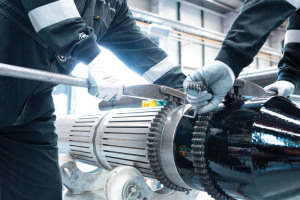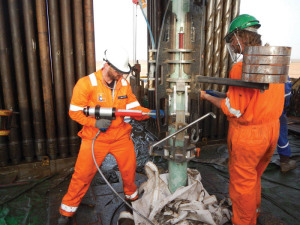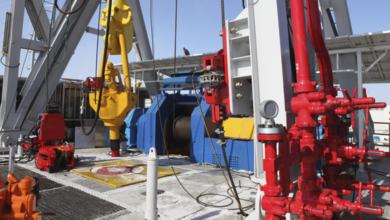Drilling & Completions Tech Digest
Mobile app quantifies drill bit behaviors, aids in selection process
By Joanne Liou, Associate Editor
Picking the right drill bit can be a daunting and time-consuming task, considering the myriad options that can be available from one single company. To assist with this task, Baker Hughes recently launched the BitGenie mobile app. It was developed to provide operators with a simplified, portable and paperless tool to facilitate the bit selection process. More than a “Google search of bits, (BitGenie is) an analytical, quantitative tool,” explained Danielle Roberts, Software Product Manager for Baker Hughes.
Launched in July, the tablet-based tool has been deployed in North America and currently has more than 300 users within Baker Hughes. The app was originally intended to be a frontline sales tool, but the company is discovering additional benefits along the way. While sales, marketing and field engineers are using the tool in the field, design engineers back at the office are also working with them in the development of new bit designs. “(Frontline) users will work with a designer, and the designer will run (design specifications) through BitGenie to see what we have or to make changes” to see how a bit would perform or how it can be improved, Ms Roberts explained.
From bit selection to operation, BitGenie can save nearly six months of time, according to the company. “A new bit design can take several weeks to design, then you add in manufacturing time,” Ms Roberts said. “After the bit is manufactured, you have to wait for the next well to come up. And in addition, selecting bits used to take days or even weeks, depending on how detailed a required analysis was to determine the selection. With the BitGenie, you get results in seconds.” The tool does not replace the salesperson or engineer. Rather, it is used to cross-reference multiple databases simultaneously. In the past, frontline engineers “were going to different databases and gathering information and having to manually compare that information, and there was no consistent way to quantatively analyze it,” she noted.
Prior to BitGenie, engineers would consider the formations that had been drilled before and the specific features of the bit – the number of cutters, blades, gauge length, nozzles, etc. “We would focus on features, and then we would have to interpret from those features how well we predict the bit would perform for the actual application – how aggressive it would be, how durable it would be,” Ms Roberts explained. “To translate those features into the performance was a very gray area. You can change the number of blades and make it a little bit more aggressive, but how much is a little bit? And is a little bit enough?”
“There wasn’t a quantitative way to definitively qualify feature changes and compare it to the application performance,” she continued. In BitGenie, each bit is rated with the behaviors of how it will perform in the field. “That’s the major difference with BitGenie. We are using behaviors, not features.”
The app gathers information from databases on Baker Hughes’ network of servers. Since the amount of data is too large to be stored in the app, the app requires an Internet connection to retrieve live data. The inventory database stays up-to-date, and it references the tech-record database for technical specification of every bit. “It’s taking application information and calculating the best fit bit design using proprietary algorithms that are able to quantitatively display the match between application and bit design,” Ms Roberts explained.
Currently, BitGenie only covers PDC bits. Baker Hughes plans to add the Kymera and tricon bit product lines in the future.
BitGenie and Kymera are trademarks of Baker Hughes.
Sensing technology enhances riser monitoring system
Aquaterra Energy has developed a new Riser Monitoring System with sensing technology. It uses a combination of riser strain measurement, subsea data logging and riser analysis processing algorithms to generate real-time operational guidance to optimize drilling and workover operations in water depths up to 100 m.
Solid-state generators improve performance, reduce emissions
FlexGen Power Systems have deployed a hybrid generator with Ensign Energy in the Jonah Field. The FlexGen Solid State Generator was used to help Ensign drill two wells over a 30-day period. FlexGen’s Solid State Generators can pair with any diesel, dual fuel or natural gas generator sets to improve power performance and reliability while reducing fuel consumption, maintenance and emissions. The generator can reduced drill time by 18 days/year for a rig, according to the company.
“The FlexGen Solid State Generator is a game changer for the oil and gas industry,” Matt McEwan, Drilling Manager for Ensign Energy, said. The generator helps “our company increase reliability, while also reducing costs and emissions.”
Casing reconnect system facilitates North Sea wells

Meta recently completed two jobs in the North Sea with its Meta Casing Reconnect technology. In one job, an operator faced casing hanger damage because of previous milling operations. As a result, the casing needed to be cut below the wellhead. A new hanger was installed, while ensuring a V0 gas-tight seal for the life of the well.
The existing casing was cut and reconnected to the new wellhead using Meta’s casing reconnect technology by morphing the new casing to the existing casing of the same inner diameter (ID). A permanent, metal-to-metal, gas-tight and axial-load bearing connection was created, providing full integrity and regaining full access to the well.
In a separate job, another operator was converting a well to gas lift to maintain efficient production. However, there was a leak in the well.
The operator required existing production casing to be cut and pulled, the wellhead seals replaced, the casing to be re-established with a deeper crossover, and a non-elastomeric V0-rated seal established, leaving the 9 5/8 -in. casing in tension. Using Meta’s Metalmorphology technology, the casing reconnect fulfilled the requirements, providing a metal-to-metal solution with flexible space-out and without reducing the ID.
The casing reconnect technology ensured double barrier, V0 integrity allowing recovery of up to 200 cu m/day in production.
Composite casing applied in Oman well

A joint venture of GE and Ferus Natural Gas Fuels (Ferus NGF), along with Statoil, plan to expand a pilot project to capture flare gas and use it to power up to six of Statoil’s drilling rigs and one frac fleet in North Dakota. The expansion is the first step by Statoil to move into full commercial adoption of the GE and Ferus NGF joint venture’s Last Mile Fueling Solution. Last Mile is expected to reduce emissions and provide cost savings and logistics solutions for oilfield operations in the Bakken.
“This is an excellent example of how collectively we can help solve a significant industry issue. Thanks to the leadership of Statoil and the partnership approach taken, Last Mile can be rolled out across North Dakota and in other states, contributing significantly to the environment while increasing the competitiveness of our customers,” Dick Brown, CEO of Ferus NGF, said.
Statoil anticipates this expansion will increase its flare gas capture to between 3 million and 5 million standard cu ft/day (scfd) by the end of 2014. This equates to greenhouse gas emissions reductions of between 120,000 and 200,000 metric tons per year, or the equivalent of removing between 25,000 up to 45,000 cars from the road.
Flare gas to power six rigs, frac fleet in North Dakota
A joint venture of GE and Ferus Natural Gas Fuels (Ferus NGF), along with Statoil, plan to expand a pilot project to capture flare gas and use it to power up to six of Statoil’s drilling rigs and one frac fleet in North Dakota. The expansion is the first step by Statoil to move into full commercial adoption of the GE and Ferus NGF joint venture’s Last Mile Fueling Solution. Last Mile is expected to reduce emissions and provide cost savings and logistics solutions for oilfield operations in the Bakken.
“This is an excellent example of how collectively we can help solve a significant industry issue. Thanks to the leadership of Statoil and the partnership approach taken, Last Mile can be rolled out across North Dakota and in other states, contributing significantly to the environment while increasing the competitiveness of our customers,” Dick Brown, CEO of Ferus NGF, said.
Statoil anticipates this expansion will increase its flare gas capture to between 3 million and 5 million standard cu ft/day (scfd) by the end of 2014. This equates to greenhouse gas emissions reductions of between 120,000 and 200,000 metric tons per year, or the equivalent of removing between 25,000 and 45,000 cars from the road.
Shell conducts trials of new shale gas testing service
Shell recently collaborated with a company called WellDog to develop a technical service to locate natural gas and natural gas liquids in shale formations. The service leverages Shell’s geochemical and petrophysical experience in shale gas evaluation and WellDog’s patented downhole Raman spectroscopy technology. The new service allows producers to focus development efforts, reduce drilling costs, optimize production and reduce the number of hydraulic fracturing stages and associated water use. Shell is currently leading beta trials of the technical service.



